Citroën
Citroën cars have many enthusiasts. Consider the Citroen DS. But also at the SM. And of course the car with the longest type designation ever: The CX 2500 GTI Turbo II. But also the 2CV. And the more modern cars like the Xantia Aktiva V6 / 2.0CT, XM V6, AX and Saxo Sport.
A small impression of the projects at Citroen's that we have implemented in recent years.
The Citroen DS
Unrivaled in comfort. The engine is unfortunately not that special technically, but it fits well with the character of the car. The i.e. versions were provided from 1973 with the D-jetronic electronically controlled injection system. This system was by no means faultless. The pressure sensor for the intake air pressure works quite roughly. The injectors have a low impedance with ballast resistance and have no best dosing and no atomization, but blow the fuel into the engine with a large jet. With the modern sensors and electronics of today, these cars undergo a true metamorphosis in terms of cold start, flexibility, power, emissions and consumption.

Citroen DS wiringloom under construction
In addition, fun things with the engine are possible. For example, it is not very complicated to convert the lower block of a Citroen CX 2500 to make it suitable for a DS. In combination with the DS cylinder bushes and pistons you get a long stroke and a large bore. The stroke volume then becomes almost 2600cc. In combination with a C35 final transmission, you will get a DS that remains powerful and comfortable.
Sensors
The engine is more difficult to provide with a modern engine management system than the average engine. This has to do with the lack of the crankshaft pulley. The only correct way to provide the engine with proper crankshaft position recognition is to install a hole pattern in the flywheel. And for that, the gearbox must be dismantled.
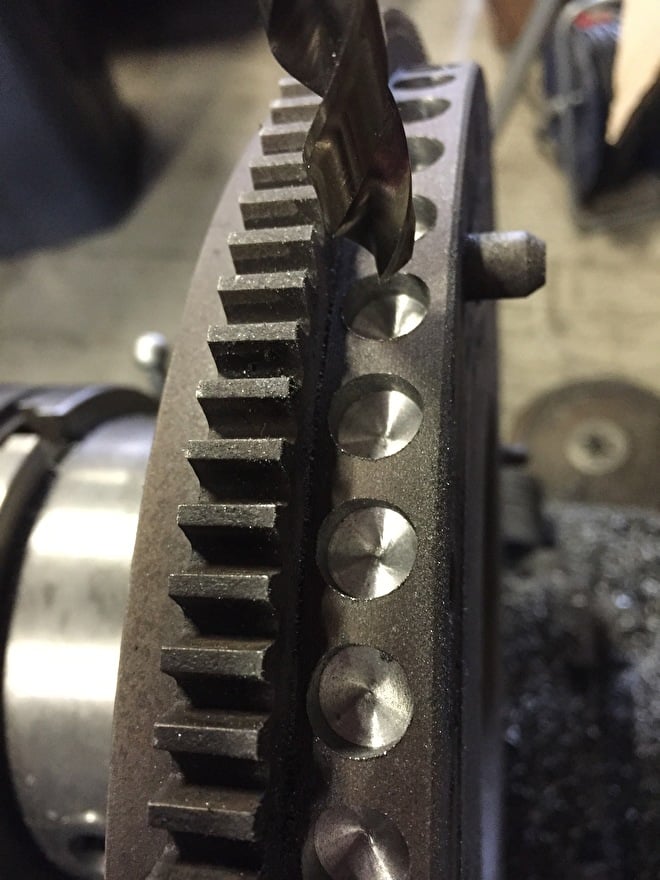
A distribution table is used to drill a 5 mm deep hole in the flywheel every 6 degrees. We do not drill 2 holes. This creates a 60-2 trigger pattern. After this we let the flywheel balance.
The drive wheel of the hydraulic pump, dynamo and water pump runs at camshaft speed. If we place a HALL sensor there, we can inject fuel sequentially. The ignition can also be controlled sequentially.
Of course we replace the coolant temperature sensor for a modern one. This can be screwed in easily.
The old pressure box is replaced by a modern MAP sensor with built-in temperature sensor and this is placed directly on the manifold for the smallest possible delay of the negative pressure signal.
The original throttle position sensor works with "steps". We install a new sensor of the potentiometer type.
Finally, we add a sensor that the DS has never had. The broadband lambda sensor. This sensor ensures that we can adjust the engine optimally in terms of consumption, emissions, performance and comfort. In this way we have equipped the DS with a cathalysator. This car therefore meets the> 1994 emission requirements on the four measured gases (oxygen, hydrocarbons, carbon dioxide and carbon monoxide) and is therefore less polluting and odorless.
Ignition
The engine can be equipped with a coil per cylinder, which fits nicely into the spark plug shaft of the cylinder head. High-voltage cables no longer run over the motor. An alternative is a distributor-free DIS ignition. And it is also possible to continue to use a single ignition coil with distributor to preserve the original looks. The timing, however, comes from the crankshaft position sensor and is therefore extremely stable and accurate, which ensures smooth engine running, lower consumption, fewer emissions and higher performance.
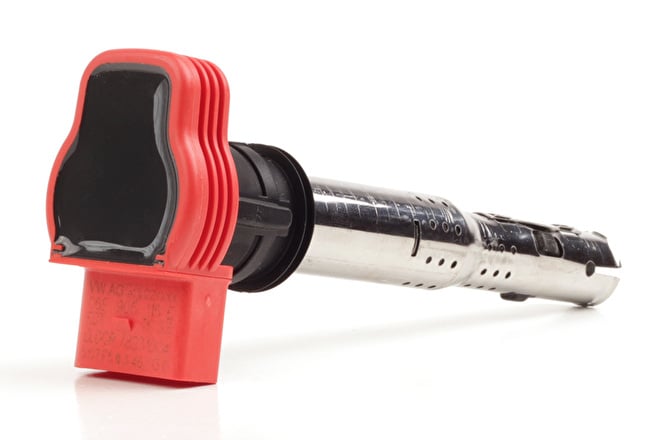
De "Penbobine". Voor de Citroën DS en CX gebruiken we een kortere versie.
Injection
Our first DS projects were still equipped with Citroen CX 2500 GTI injectors. But these injections were not really an "upgrade". In addition, they have already used a best message and they are no longer for sale. That is why we have come up with a way to enable the installation of a new type of Bosch EV14 injector. We have found a very compact injector and made a special adapter. This gives us a much nicer atomization and dosage of fuel. The problem of the digestive fuel hoses of the injector has also been solved. These are now very easy to service. Simple, but very effective.
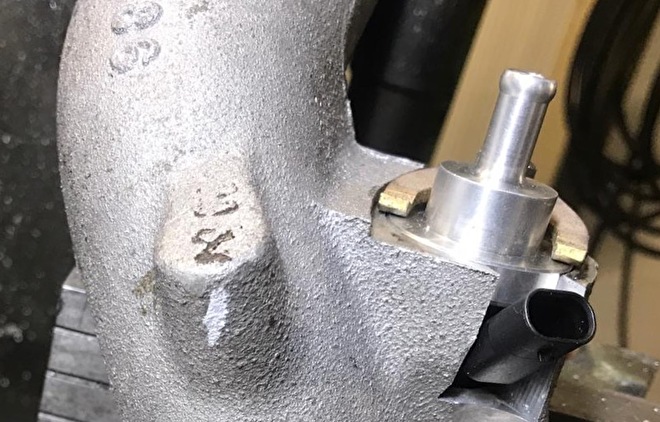
De echte injector upgrade voor de Citroën DS en SM
Air circulation valve
The DS originally had a range of valves with washing elements and air circulation systems. Certainly the Hydraulique models. We can replace all these systems with 1 component. The stepper motor. This controls the static speed very precisely. The ECU can get an input from the brake contact in order to lower the speed even further for the semi-automatic versions.
Citroen had big plans with the DS in terms of motorization. Unfortunately, little came of that and it now has the legacy of the traktion avant. Still, the relatively simple four-cylinder can run beautifully and fits well with the car.
Tested in a rally car
Finally an image of our system in action: the Rally DS of Harry Martens from Limmen. This car is exposed to considerable hardship almost every week during rallies. And he regularly has something to repair. The only thing he has never had problems with is the engine management system that we have installed for him. The testing ground for reliability and performance!

De Citroen DS Rally van Harry Martens
We have complete conversion kits available for the Citroën DS.
Necessities
- ECU + Wiring harness
- Modification flywheel + balancing and crankshaft position sensor
- Throttle position sensor
- Coolant temperature sensor
- MAP sensor
- Air temperature sensor
- Broadband lambda sensor
- EV14 injectors + adapter for the best results
- 1x ignition module 1 channel / 1x DIS ignition coil + cable set / 4 pin ignition coils
- Stepper motor
- Installation package
The Citroën SM
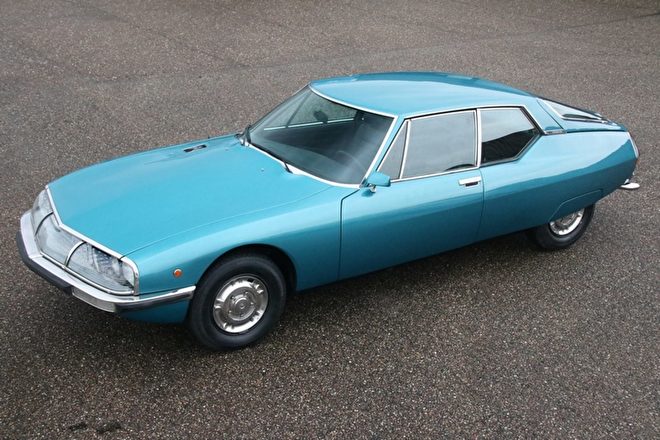
The EFIgnition developed around the SM engine. The SM has an odd-fire 90 degree V6 Maserati engine designed by Mr. Alfieri. Typo C114. In principle, it was supplied in a carburetor version. Unfortunately, carburetors have some problems. The lead plugs rot out. The fuel in the float chambers evaporates, so the engines often start poorly. Carburetors are struggling with the current fuel (ethanol content) and are now worn out. The first injection models came in 1973. After a few years, these were frequently converted to the simpler carburetors. This is wrong, because the injection models can run much better than the carburetor models!
The modernization of the engine control
The conversion of the SM to modern fuel injection and electronically controlled ignition has enormous advantages. For example, we have seen an improvement in practical consumption from a normal 1 liter per 8 kilometers to 1 liter at 13 kilometers. The engine runs very smoothly and delivers great torque over the entire speed range. The cold start is no longer a problem and the wear and tear of the engine is over by the precise dosing of the fuel. No more gasoline that pollutes the oil. Also in the city and traffic jams it is now excellent to drive without weird behavior. If you give the car space and you accelerate ... Then the beautiful sound of the odd-fire V6 engine comes up. The torque starts at a low speed and as the revs increase the horsepower increases. In combination with the hydraupneumatic suspension and the Diravi steering, this gives a unique experience.
We have provided many SMs with new electronics and were the first pioneers. The odd-fire engine is not an easy engine to fathom. And it has cost us some sweat and tears. But this was more than worth it!

Aan het werk op locatie bij een klant aan de fantastische odd-fire V6 van Maserati
Sensors
A modification to the flywheel is necessary for a proper conversion. Only then does the ECU receive a reliable crankshaft position signal and this ensures optimum timing and precision of the ignition moment. In addition, this engine MUST be equipped with a camshaft sensor. The reason for that: the odd-fire V6 design. This can be placed on the intermediate shaft. Together they form the basis for a new way of lighting.

Vliegwiel Citroen SM met 36-1 triggerpatroon
The engine is equipped with a new coolant temperature sensor. This fits in the original hole.
The MAP sensor is connected to the manifold through a hose. But not on the original connection. Citroën made a mistake there in 1973 by placing that connection directly opposite an inlet pipe. As a result, the measured pressure at certain speeds will deviate from the actual pressure.
An air temperature sensor is placed in the air flow between the filter and the gas valve.
The standard throttle position sensor works with "steps" and is not usable. We mount a potentiometer type gas valve position sensor.
Finally, a broadband lambda sensor enters the outlet to control the mixture very precisely under all circumstances.
Injection
There are 2 options. The carburetor models benefit the most from injection manifolds. But these have become very scarce and thrown in the trash by many after an injection-carburetor conversion. An alternative is to replace the carburetors with throttle housings in which injectors can be placed. So-called "Individuval Throttle Bodies" or ITBs. I prefer the original injection manifolds. But the ITBs already give a lot of advantages over the carburetors.
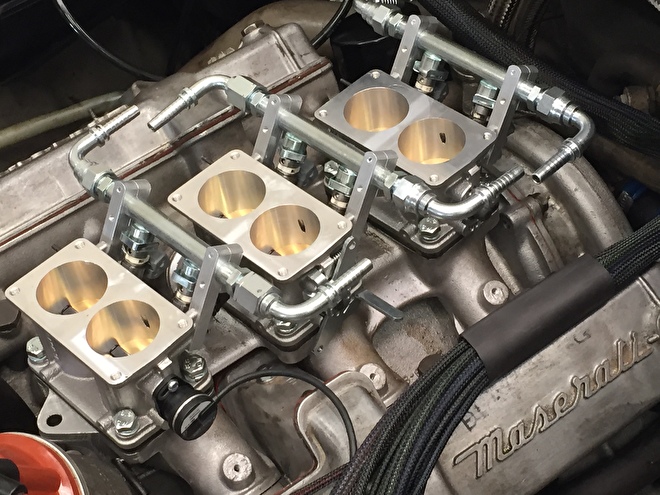
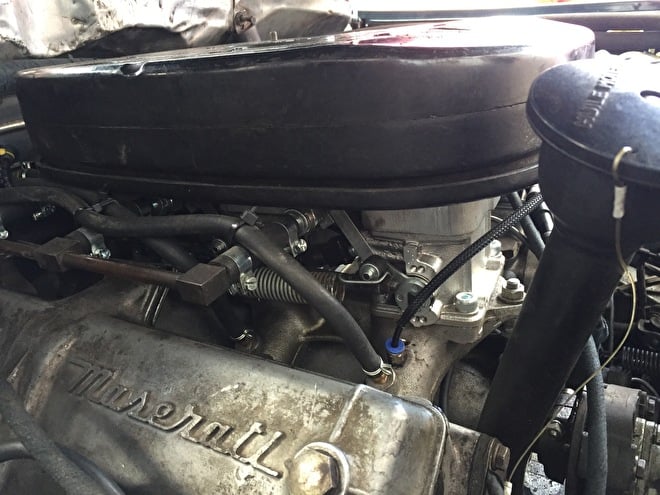
Citroen SM voorzien van ITB gasklephuizen en een spacer zodat het luchtfilter weer op de originele plek komt
If the engine has injection manifolds, we will replace the injectors with new Bosch EV14 injectors. The injector is mounted in the manifold through a special adapter. This makes the rubber hoses of the injectors serviceable again. The new injectors dose and atomize better, making the engine quieter, more efficient and more powerful with less consumption and emissions.

De nieuwe Bosch EV14 injector past in het originele spruitstuk en geeft een betere verneveling en dosering. De slang aansluiting is servicable.
Ignition
The ignition of the Citroën SM is special. Originally, the designer Alfieri approached the engine as 2 separate 3-cylinder engines. There were 2 contact points. 2 ignition coils and 1 split rotor / distributor, each with its own ignition coil, providing its own cylinder row. Adjusting these contact points was not easy and a special test bench was needed to synchronize the moment of ignition between the different cylinder banks.
Slimmeriks like Van de Laan, Rootselaar and 123 ignition had thought that it could be better with 1 ignition coil. But they made a big mistake. Due to the odd-fire configuration you could partly see it as V8. The ignition takes place every 90 degrees to 150 degrees. It is just about 90 degrees. If we run 6000 rpm, the cycle time of 2 crankshaft revolutions is 20ms. If we calculate with 90 degrees, then we are left with: 720 degrees / 90 degrees = 1/8 of those 20ms. That is 2.5 ms. The ignition coil must be loaded in these 2.5ms and the spark must be made. A normal loading time of an ignition coil is approximately 2.3 ms. The duration that must be reserved for the spark is 1 ms. So there is only 1.5 ms left for the spark. 123 ignitions in particular use less powerful ignition coils because their integrated end stages otherwise become too hot and therefore require an even longer loading time to be able to make a spark of sufficient strength. The original approach to Citroën (or Maserati) was not that bad.
It can also be different. With the EFIgnition you can choose:
- An ignition system with 1 ignition coil in combination with the PRV rotor / distributor cap (just like the Van der Laan, Rootselaar and 123 but with a much more precise timing).
- An ignition system with 2 ignition coils, similar to the original Maserati design. But then again with an exact timing of the ignition moment without passing through the crankshaft position sensor, camshaft sensor and the ECU instead of (expiring) contact points.
- An ignition system with 6 ignition coils. This actually the best solution for this engine. The load time problems are absent. Only very short high voltage cables are needed. And the distributor has become superfluous. We apply this conversion the most. This is also the most easy to apply because you cannot be mistaken with the ignition sequence and spark plug cables. Then you can still talk about originality. But in the end the intake manifolds come over it and so you don't see anything of it anymore. But do you have a fantastic and maintenance-free ignition system that you can rely on.
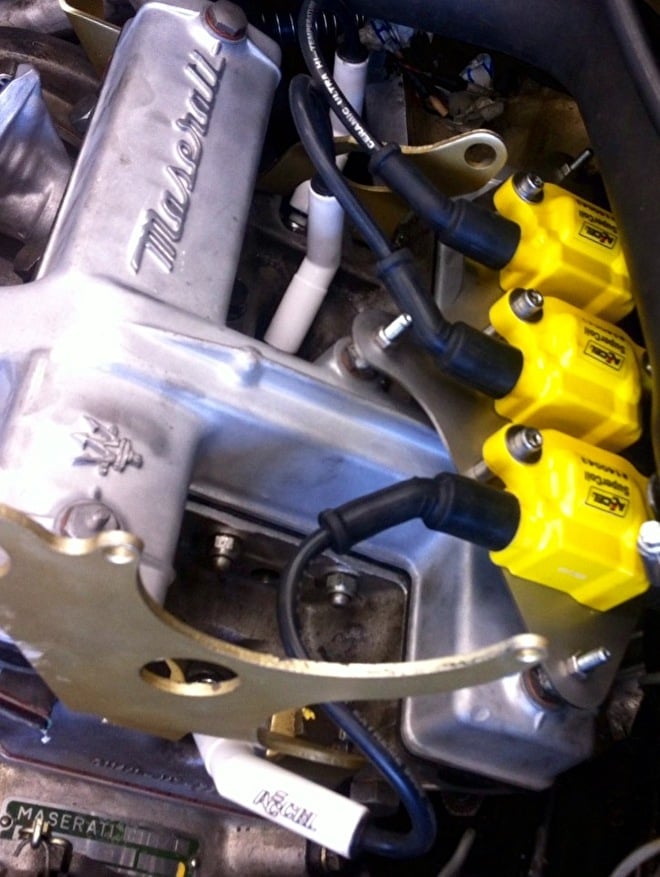
De Citroen SM motor voorzien van 6 losse bobine met korte hoogspanningkabel
Idle Air Control Valve (IACV)
We use a modern stepper motor for very precisely adjustable idle speed. This makes the closed loop motor adjustable and functions such as "dashpot" can be activated (temporarily slightly increasing the idle speed in the event of sudden gas release to prevent oil consumption and turning off).
We have complete conversion kits available for the Citroën SM.
Necessities
- ECU + Wiring harness
- Modification flywheel + balancing and crankshaft position sensor
- Throttle position sensor
- Coolant temperature sensor
- MAP sensor
- Air temperature sensor
- Broadband lambda sensor
- EV14 injectors + adapter for the best results
- 1x ignition module 2 channel / 6 individual ignition coils
- Stepper motor
- Installation package
Citroen CX 2500 GTi (Turbo)
We regularly come across the Citroen CX with the 2400 and 2500 engine in our workshop. The crankshaft pulley is also absent from this engine. We regularly supply kits to CX-Basis in Germany for these cars. They have experimented with a trigger wheel behind the distribution cover. But in the end they abandoned that plan and now they just apply the modification to the flywheel, just like the Citroen DS and SM. This also makes the engine a more difficult candidate for conversion.

Prototype aanpassing distributiedeksel van CX-Basis.de

Met een verdeeltafel wordt iedere 6 graden een 5mm diep gat in het vliegwiel geboord. 2 gaten boren we niet. Daarmee ontstaat een 60-2 trigger patroon. Hierna laten we het vliegwiel balanceren.
The Turbo models are the nicest to tackle. That is where you win the most. The engines are wonderfully smooth and deliver fantastic torque. That the engine has to be removed for adaptation to the flywheel is again not a major disaster. The seal of the price axis of the gearbox is often leaky, so that the clutch housing is full of cooking oil. With a new engine management system, the engine can easily deliver more torque. But the clutch is the weak link in the powertrain of the CX Turbo. This will slip almost immediately as soon as the turbo pressure is increased slightly. The link must therefore already be replaced if you want to experience a little extra pleasure with the upgrade.
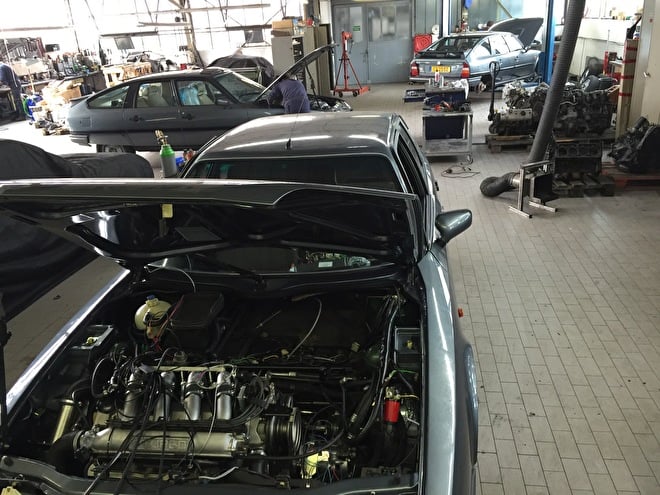
Aan het werk in de werkplaats van CX-Basis.de
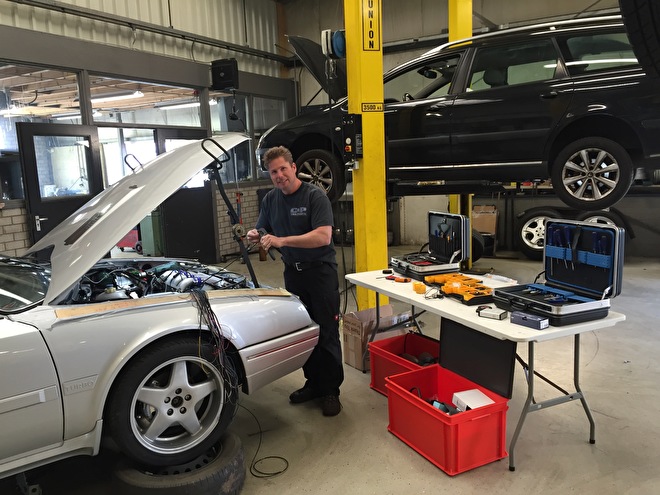
Inbouw op lokatie bij PSA specialist
Optionally, a catheter can also be added after conversion. This makes the car less environmentally harmful. Apart from the coupling, this engine needs no further adjustments. We do, however, recommend replacing the old-fashioned low-impedance gasoline injectors with new EV14 injectors. These dose and spray better. This makes the engine run quieter, nicer, more economical and stronger. A boost-control solo can also be added so that the turbo pressure can be regulated electronically. The turbo pressure meter in the dashboard continues to work.
Necessities
- ECU + Wiring harness
- Modification flywheel + balancing and crankshaft position sensor + bracket
- Throttle position sensor
- Coolant temperature sensor
- MAP sensor
- Air temperature sensor
- Broadband lambda sensor
- EV14 injectors + adapter for the best results
- 2x DIS ignition coil + 2 channel ignition driver / 4 pin ignition coil
- Stepper motor
- Boost controller solonoid for turbo engines
- Installation package
Citroen Xantia / XM V6
This motor is also a great donor for the Alpine for example. Even in the Volvo 260 we came across this one time. They were known for their problems with the camshafts. But if the engine is kept clean and provided with the modifications of the latter types, then it is truly an executioner of an engine. In a positive way.
The switching inlet route, consisting of 2 stages, is special. So in total 3 configurations are possible. The EFIgnition is perfectly capable of correctly controlling these valves and the effect is actually noticeable. The engine has a flat torque curve if both valves in the inlet are set correctly. If you put them the wrong way, the engine becomes explosive in giving off its power. The engine is weaker in certain speed ranges, but oddly enough, it gives you the impression that it is actually stronger. This has to do with the fact that a (strong) linear acceleration is harder to sense than a progressive acceleration.
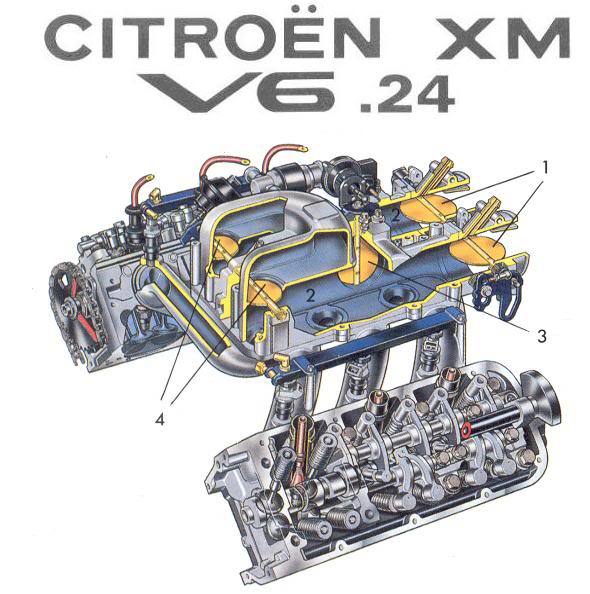
Complex, maar effectief inlaat spruitstuk van de V6 24V
Citroen AX / Saxo / TU engines
These cars are often equipped with the well-known TU engines. These are relatively simple engines, but capable of major actions due to their robustness. For example, we have equipped a Saxo with a new engine management system in combination with a compressor. Without further mechanical adjustments to the engine. It was a bizarre experience. And it just remains whole. The nicest version is the 1.6 16V. This is a nicely designed motor with the solid bottom block of the TU. But with the 16V head. The motor runs vibration-free, wants to make a tour. We encountered this engine in an AX with Dbilas throttle housings. If you did not know in advance that it was the 1.6 you would suspect that it was a much larger engine. These engines can easily go over 300 hp in combination with a turbo. The EFIgnition is a very good ECU for these engines. Many parts are standard on the engine. Make sure you use a multipoint injection engine as the basis.
2CV
The nicest means of transport in the world. And it can be even better. Among other things, we helped the Burton Car Company develop injection kits. But well before that time, we provided various "Ugly Ducklings" with injection and electronic ignition.
Sensors
The basis is again the adjusted flywheel. The 2V does not have a speed record on the crankshaft as standard. The 123 ignition is often used, but I hear from many customers that they break down very regularly. Time for the right approach.
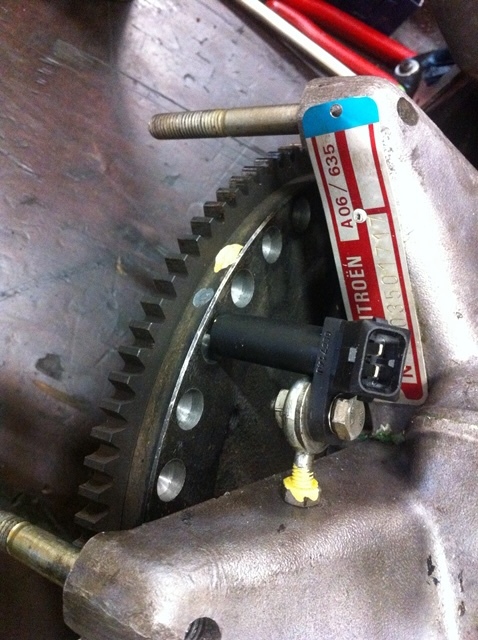
Met een verdeeltafel maken we 5mm diepe gaten in het vliegwiel. Precies iedere 10 graden maken we een gat. In totaal 36 gaten, waarvan er 1 ontbreekt (de missende tand) Een inductieve sensor "leest" de gaten en verteld de ECU wat de krukas hoek op dat moment is.
We measure the temperature of the engine in the warmest place in the forced air cooling cover plate. We no longer use the standard fan, we install an electric fan. The ECU controls the switching on of the fan. In practice, the engine rarely appears to have to cool.
We place a MAP sensor to measure the pressure in the manifold.
The throttle body is used from an Aygo engine. An adapter plate ensures that it fits on the manifold. The Aygo throttle body already has an air temperature sensor and a throttle position sensor. By applying this throttle body, we also immediately have a stepper motor at our disposal. This is integrated in the throttle body. This allows us to adjust the idle speed very precisely.
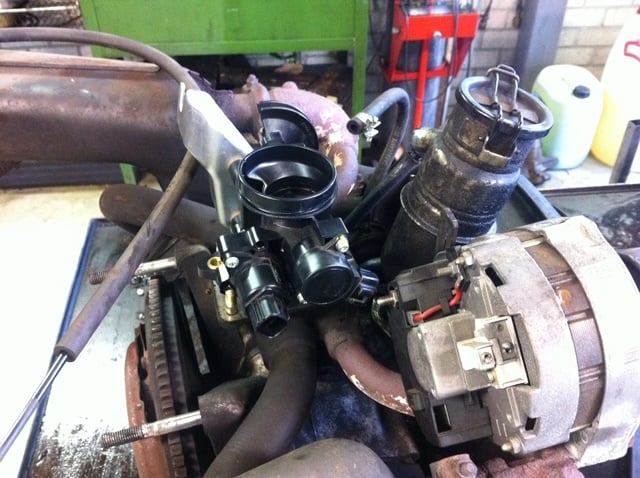
Citroen C1 of Aygo gasklephuis op de 2CV motor
Next, we make a broadband lambda probe in the center silencer. Optionally, a sensor can be built in where the original contact points were. Then the 2CV receives a fully sequential injection and inflammation.
Injection
We use injectors with the smallest possible flow (cc / min) that we could find. This appears to be a great match. The modern injectors spray nicely, dosing nicely. So beautiful that the 2CV can be adjusted very low in speed without skipping. Keep an eye on the oil pressure.

Plaatsing van de 2CV injectoren
Ignition
Instead of the standard single ignition coil, we placed 2 separate ignition coils. But in itself it makes no difference which ignition coil system is chosen, the more modern Visa ignition coil can also be used.
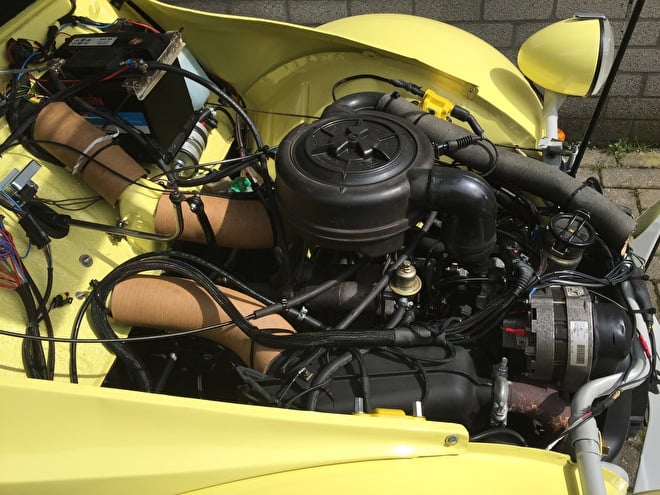
Het eend-resultaat
The result is a 2CV that runs much nicer stationary. Has become noticeably more powerful. Has become a lot more economical. And important with an open car: less stink / produces emissions. Optionally, the addition of a catalyst is possible. Of course this conversion is also possible on a Lomax or Burton. A GSA 4-cylinder boxer engine can have a similar conversion.
Necessities
- ECU + Wiring harness
- Modification flywheel + balancing and crankshaft position sensor
- Throttle body Aygo / 107 / C1 with sensors
- Engine temperature sensor
- MAP sensor
- Broadband lambda sensor
- EV14 injectors + welding sleeve
- 2x ignition coil + spark plug cables
- Installation package

